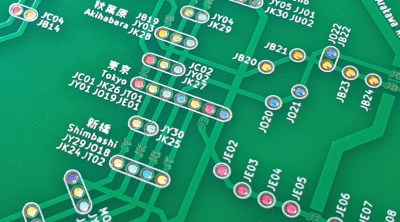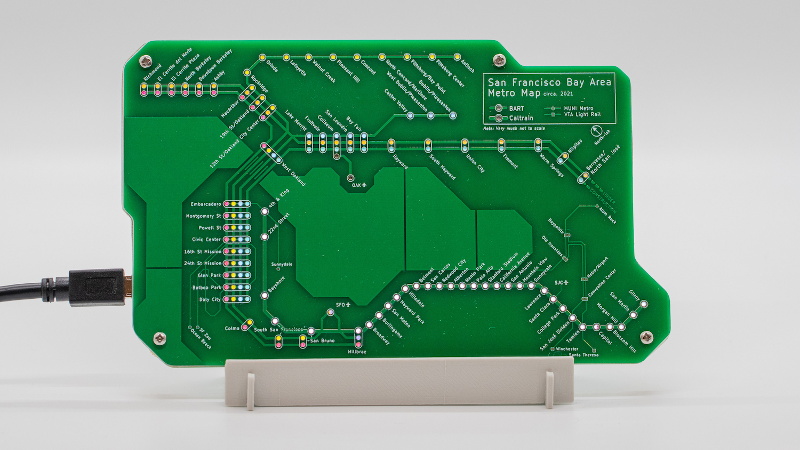Is your love of public transportation matched only by your passion for designing custom PCBs? If so, then you’re going to love these phenomenal transit maps created by [Chai Jia Xun]. Using the painstakingly refined principles outlined in his detailed write-up, he’s created versions for Tokyo, Singapore, and the comparatively spartan San Francisco Bay Area. All you need to make one up for your home town is an incredible amount of patience and dedication. No problem, right?
As [Xun] explains, the first part of creating one of these maps isn’t unlike generating a normal PCB. Just make a footprint for the stations, consult with Google Maps as to where they should be placed on the board, and then connect them all up with traces to stand in for the rail lines. A little silkscreen work, and you’re done.
 Well…unless you want them to light up, anyway. To pull that off, [Xun] created a second PCB that places an LED behind each station hole drilled in the previous board. With a microcontroller and shift register, he’s able to selectively illuminate individual lines and run through different patterns. To combat light bleeding through the PCB, a CNC-cut piece of 3 mm MDF sits between the two boards to make sure each LED is only visible through the respective hole in the top surface.
Well…unless you want them to light up, anyway. To pull that off, [Xun] created a second PCB that places an LED behind each station hole drilled in the previous board. With a microcontroller and shift register, he’s able to selectively illuminate individual lines and run through different patterns. To combat light bleeding through the PCB, a CNC-cut piece of 3 mm MDF sits between the two boards to make sure each LED is only visible through the respective hole in the top surface.
You could call the map finished here as well, assuming you don’t mind all the stations lighting up white. If you want them to be different colors, you’ll need to insert some colored diffusers. [Xun] went through several different approaches here, but in the end, the idea that seemed to work best was to simply print out all the colored dots on a piece of transparency paper and use a second sheet of tracing paper to soften the light. Alignment here is critical, but once everything is dialed in, the results are quite impressive.
It’s quite a bit of work, and we haven’t even mentioned the fact that [Xun] had to modify the circuit when it came time to do the Tokyo map, as some MOSFETs had to be added into the mix for the microcontroller to reliably control 350+ LEDs. So there’s certainly no shame in simply buying one of them when they go on sale instead of trying to recreate it from scratch. Assuming you live in one of the cities he’s offering, anyway. Otherwise, you might want to take a look at our HackadayU class on KiCad and get yourself a comfortable chair.















Also check out Yuri Suzuki’s Tube Map Radio (2012) > https://yurisuzuki.com/archive/works/tube-map-radio/
Misleading title: that radio doesn’t use (vacuum) tubes!
B^)
What if you silk screen the entire map to make the appearance of traces? You can then use the top layer as a light filter, and then the back layer can hold the leds pointed towards the board.
For beginners: make one for Serfaus, the world’s smallest town with an underground air cushion guided cable-hauled public transport system. It has 4 stations.
So much surfing, just to find out what some commenter meant when throwing a new word at me.
https://en.wikipedia.org/wiki/U-Bahn_Serfaus
Nice! Would love to see a London Underground version.
That’s something that I’m thinking of working on next, though I’ve only been there once so I’m not that familiar with the place.
I’ll see if I can find a link to this. But, I believe the London underground was the first ‘system’ to be mapped in this way and if that is strictly the case, then your adding it to your portfolio, would add some quite historical value to the set/collection. The following link will let you download a PDF copy of the standard ‘London Tube map’
http://static.visitlondon.com/assets/maps/travel_maps/tfl_underground_map_reg_user_07-E-1736.pdf
And here’s a ‘Wiki’ link to the origins of this style of ‘mapping’ which confirms my fuzzy memory on the subject.
https://en.wikipedia.org/wiki/Tube_map
P.S. Brilliant job by the way!
That map is out of date as of this morning I think ? Doesn’t have the new northern line extension :-D
Daughterboard in the works!
B^)
https://www.traintrackr.co.uk/product/tfl1 – it exists!
Great idea, but unfortunately I think the execution could have been much better. No station names on the map, the components should be on the bottom side of the board, the lines could have been with their actual official colour… things like those.
Hopefully the author will work on it
Remember that Harry Beck originally conceived the London map (the first of its kind) as a circuit diagram > https://i.pinimg.com/originals/08/45/0b/08450b9bee1b009c75b25db4a06e3e58.jpg – which Yuri Suzuki (link above) references
I play this game all the time. I’m hoping to unlock Berlin soon.
Beautiful work. I’ve always though using PCBs for art such a great idea. Hope to see a London Metro version from Xun.
Back in 2015 I bought a couple of card holders from https://pcbartmoeco.jp/index.html of the Tokyo and Paris underground and they are lovely things to have our Passmo cards in when visiting Tokyo.
Someone sent that to me too! It looks super cool and I might get one of my own too.
How about using WS2812-style (or similar) LEDs that need only 1 shared data line to be individually controllable? Then, not only can you have custom colors and brightness, but you can also show train positions for systems where the data is available.
This is beautiful! I just love PCB art.
That’s a pretty cool idea !
Might be cool to have one for the st louis metrolink rail network even if it is an above ground system.